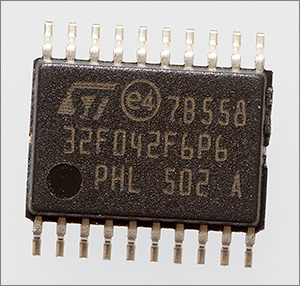
[tps_header][/tps_header]
It’s been a while since I posted a new article, a delay at least partly due to me herniating a disc in my neck which left me completely unable to look downwards for any length of time and as you’ll know all too well you can’t work on circuit boards without peering down at them. Look after your neck and back folks, and I mean that seriously.
Well I’m back now and I’ve got a lot of ideas for articles spinning around in my head that will hopefully come to fruition over the next few months. First off the block is this one in which I’m going to present a simple development board for the STM32F042 in the easy(ish) to work with TSSOP20 package.

STM32F042 TSSOP20 0.65mm pitch package
This project came about because I’m using the STM32F042F6P6 (32Kb flash, 6Kb SRAM) in another project where I’m creating a USB device and the first thing I did is try to obtain a development board for it. I was hopeful that ST would have created one of their ‘discovery’ boards but no, there was only a ‘nucleo’ board available and that had one of the QFP packages on it.

The F042 nucleo board
The nucleo board would have probably been sufficient for my needs but I do prefer to work on the actual device that’s going to be used in the real project and I had a few ideas for features that I’d include that I wish would be included in other development boards but never seem to be.
Development board features
- USB. The 042 series supports USB and although 32Kb is not a lot of space to include a USB driver and your application logic it does make sense to hook up those USB data lines and thereby enable USB device development.
- Switching regulator. All the development boards that I’ve seen seem to use a low dropout regulator (LDO) to supply power to the MCU which means that they’re unable to supply much current to any peripherals that you’re prototyping. The discovery boards warn you not to draw more than 100mA and many of the 3rd party boards use one of the 1117 regulators which, with up to a 1A limit, look great on paper but the universally chosen SOT-223 package will burn up in smoke long before you get anywhere near that figure.
- VDDA control.The discovery boards allow you to supply VDDA externally if required. I’d like to keep this ability.
- Onboard 8MHz crystal. All the F0 series can be clocked from the internal high speed internal (HSI) 8MHz oscillator with an option to use an external 8Mhz crystal. I’ll include such a crystal on my board.
- Onboard NPN transistor. I often need to use an NPN transistor as a low-side switch to control a load either requires too much current to power from a GPIO or is running from a different voltage level (e.g. 5V). I’ll include a simple transistor on this board configured ready to function as a switch.
- A LED. Because, well, you know, blinky.











